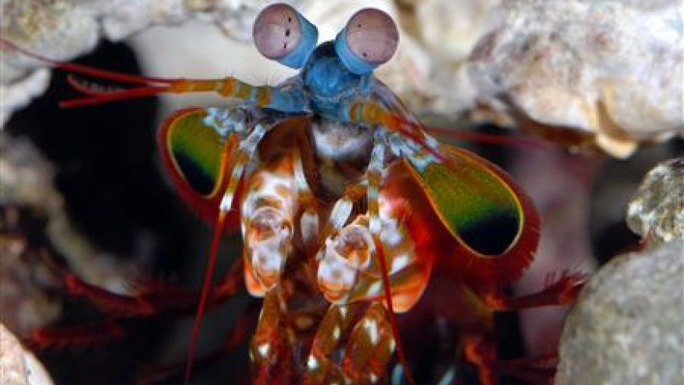Mantis shrimp (REUTERS)
In the seemingly endless fight against cancer, flowers, barks, snakes, scorpions and various toxic sea creatures are part of an ever-growing pharmacopoeia of medicines and tools. Now, research shows that a flamboyantly colorful sea inhabitant, the Mantis shrimp, may possess useful skills in the cancer war as well.
The marine crustaceans, also known as “thumb splitters” for the ability of their claws to cut skin or even dismember fingers if handled incorrectly, are typically bright red with prominent eyes, purple, pink and green highlights and can grow as long as 12 inches in length.
Unlike other creatures that may possess toxins or peptides or other chemical agents that act as chemotherapeutic drugs, the Mantis shrimp possesses a unique ability to detect cancerous tissue- just by looking. Scientists at University of Queensland in Australia have found that the eyes of this shrimp can detect polarized light, and this enables the shrimp to differentiate between healthy tissue and cancer. This is because polarized light looks different on different types of tissue or cells.
In a paper entitled “Nature’s elegant and efficient vision systems can detect cancer,” the University of Queensland researchers said that polarized light reflects differently from cancerous tissue to healthy tissue, and that the Mantis shrimp’s unusual visual system is the blueprint for new cancer-detection technology. This discovery of visual cancer recognition has science and technology developers figuring out how to create instruments which perform the same function. Right now, a team of inventors from Australia, the United States and the U.K. is hard at work developing a highly sensitive camera that will mimic this ability. In the future, this technology could be sufficiently advanced enough that it might be incorporated into your cell phone, enabling you to conduct a cancer scan while shooting a selfie.
The Mantis shrimp has unusually complex and precise vision, and this helps it to navigate in the marine environment, finding food on the sandy ocean floor, and detecting threats nearby. The eyes of the shrimp are divided into three sections, each with specialized color detection and depth perception. The result is an unusually elaborate visual system.
Various creatures and derivatives from them are now either being studied for their roles in the fight against cancer as drugs, or for other peculiar properties. The cone snail, a marine creature, has as many as 500 toxins in its arsenal of self-defense mechanisms, a number of which are being studied for their anti-tumor activity. The centipede, whose bite is poisonous, is a long-used remedy against Parkinson’s disease in China, noted for its capacity to halt progress of that disease in many cases. The death-stalker scorpion, on the other hand, possesses a toxin that can transport cancer drugs into the brain, to directly target cancer cells. In fact, almost all significant studies in the field of cancer drug development are from nature.
This is not the only example of other non-drug capabilities of natural creatures. Hornets can accumulate electrical energy in their saliva, and this is being researched for defense purposes. The gecko, on the other hand, holds itself against even the smoothest of surfaces, by a means known as “molecular closeness,” in which the cells of the gecko’s paws actually look into spaces between surface molecules. This also is being exploited by defense developers for future wall-walking by special operations soldiers.
“Nature has come up with elegant and efficient design principles, so we are combining the mantis shrimp’s millions of years of evolution – nature’s engineering – with our relatively few years of work with the technology,” said Justin Marshall of the University of Queensland’s Brain Institute. Video cancer scanning devices based on the Mantis shrimp’s unique eyes is apparently well underway in development, showing that yet again nature holds remarkable and highly valuable secrets that can aid us in the pursuit of healthier lives.


